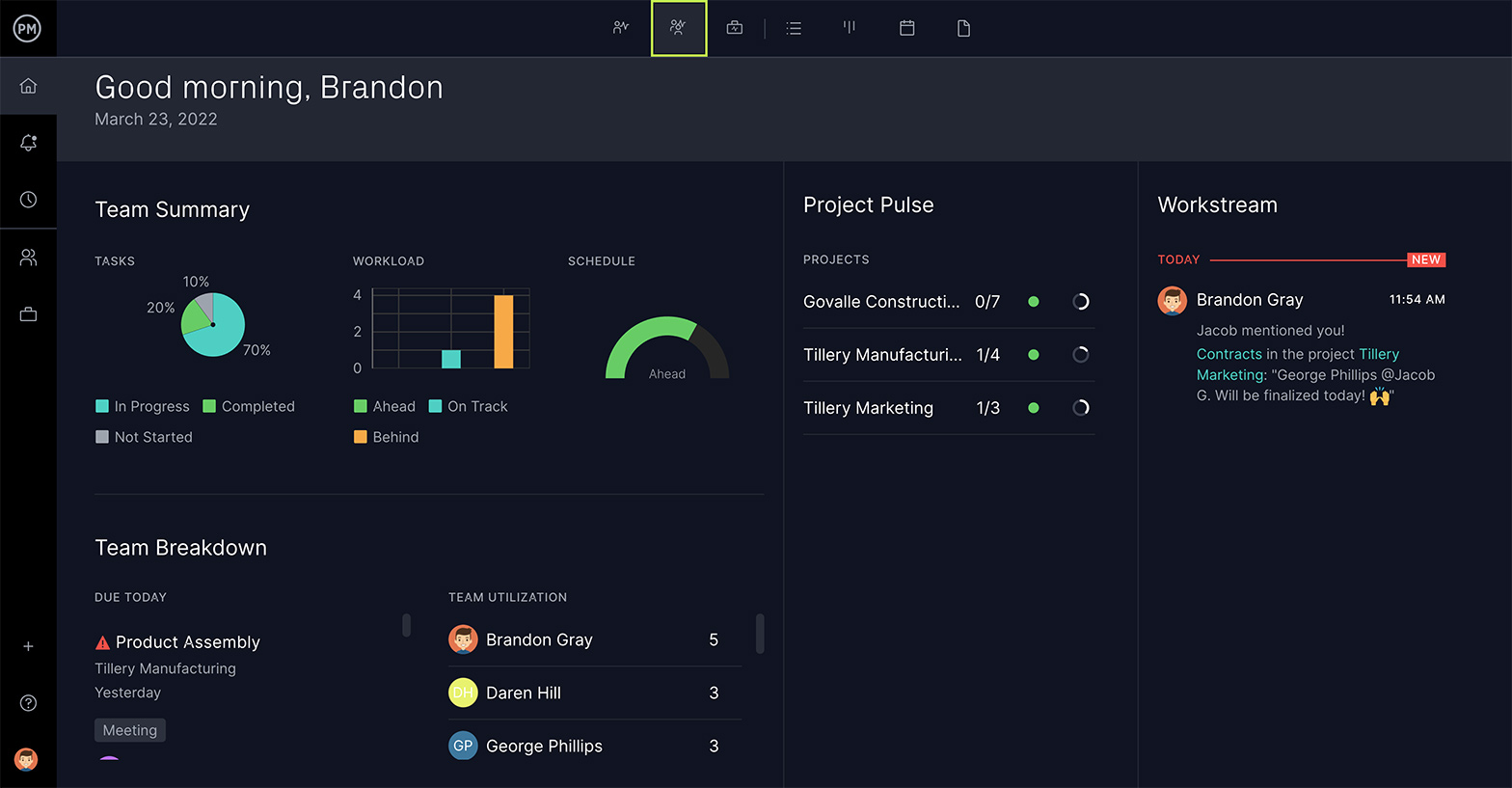- What Is Team Management?
- Why Team Management Is Important
- What Is Team Management Software?
- Benefits of Online Team Management Software
- Must-Have Team Management Software Features
- How to Manage a Project Team with Online Tools
- How to Manage a Team
- Team Management Skills
- Team Conflict Resolution
- Team Recognition
- 5 Inspiring Teamwork Examples
- Get Team Management Software Free for 30 Days
- Team Management Resources
What Is Team Management?
Team management is all about working with your team to help them collaborate and be more productive. It also refers to the activities and tools that allow teams to work better together. That means managing assignments, schedules, workload and more.
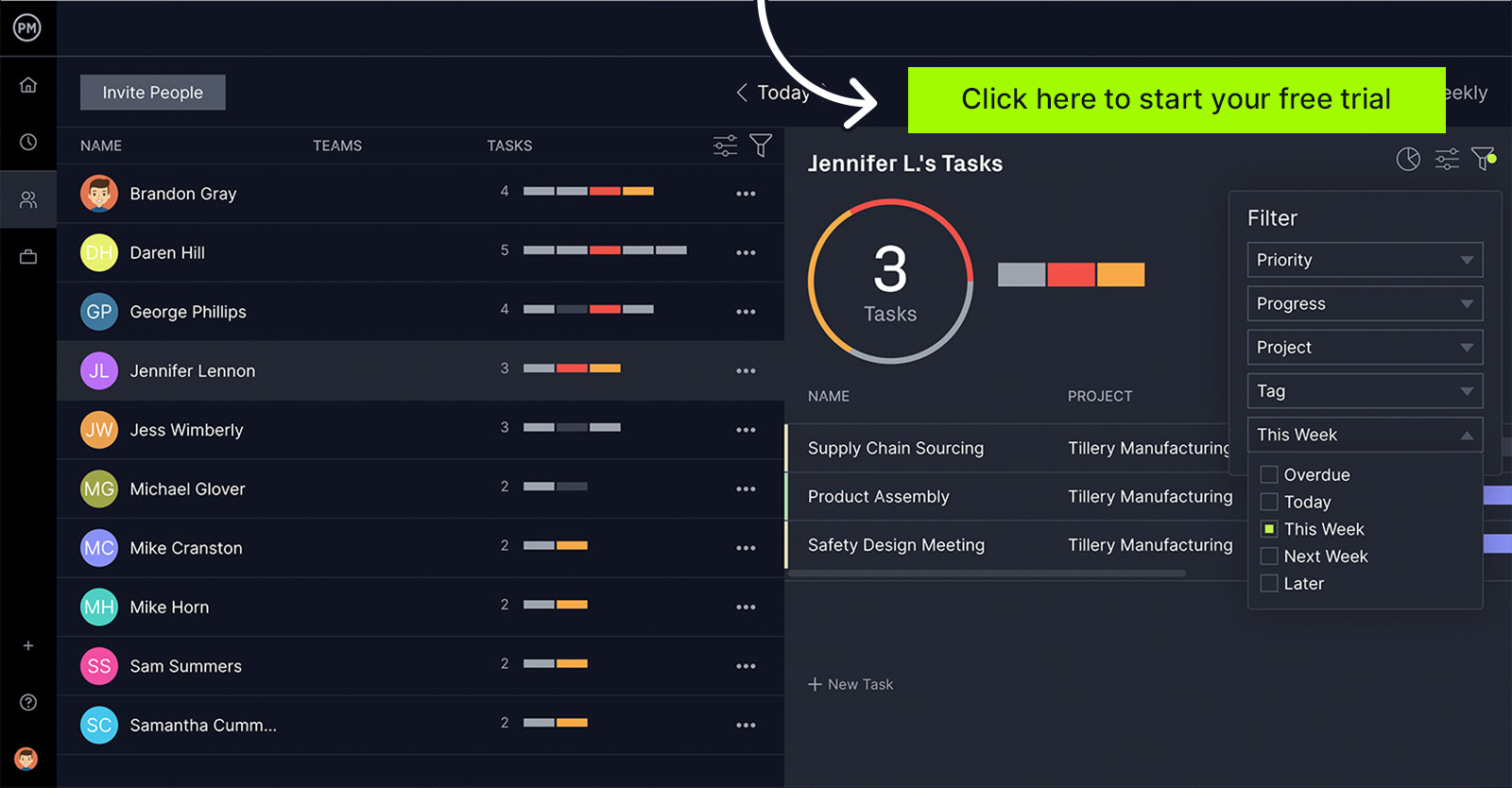
To best manage teams, you need to set clear objectives, help facilitate teamwork, have clear communications and oversee performance, while adjusting workload as needed to get the most out of your resources. This also means seeing issues and resolving them before they become problems that sidetrack the project.
Therefore, team management is a day-to-day activity when running a project. It touches almost every phase and method of project management. For example, when you’re scheduling a project and prioritizing tasks, what you’re doing is fundamental to team management.
Why Team Management Is Important
A team is the fuel that drives a project. They take tasks, and with expertise and experience, complete them according to your plan—on time and within budget. To do this requires thorough administering and coordinating.
That’s easier said than done. There are objectives to meet, communication channels to create, collaboration to foster and being able to appraise your team’s performance all while in the midst of running the larger project.
The main importance of team management, then, is that it helps to bring your project in successfully. But there are more benefits that might not be as evident.
Team Building
Teams work better when they work together. But not everyone on a team clicks immediately. You must promote the collaborative nature that bonds team members into an effective team. That means assembling the right team and giving each member responsibilities that fit their skillsets. You can also try team building activities to create a collaborative environment.
Productivity
We touched on this before, but it’s worth emphasizing. Team management serves the project by getting teams to work better. That doesn’t mean driving them until they burn out, which is counterproductive. Rather, it’s about balancing their workload, creating reasonable timelines, supporting them and removing obstacles that prevent them from succeeding at their tasks.
Education
Teams are not static. You probably will use the same team for similar projects. The more experience they have, the better they’ll work. Having a team that is well managed means that, as you add new team members, they will have less of a learning curve and be helped to get up to speed by the more experienced members. As teams gain experience and skills they become a more valued asset.
Morale
Giving teams what they need to do their work is not only going to increase their productivity, but they’ll be happier. Happiness might seem insignificant in the larger business environment, but happy teams are not only more productive. They are easier to retain and mean less turnover, which saves money.
Performance
Similar to productivity, performance speaks to the larger subject of helping organizations meet their goals and objectives. Team management creates stronger teams that meet the targets of the larger organization while they work on the smaller tasks of individual projects.
What Is Team Management Software?
Managers use team management software to connect and monitor their teams and enhance their ability to work better together. A quality team management tool improves collaboration by opening clear communication between team members, while also giving managers features that help balance resources and keep everyone working at their capacity.
Key features of team management software include team scheduling, resource management and deep reporting. In terms of communication tools, software sometimes features unlimited file sharing and notifications that alert managers to updates.
Managers and teams work differently, of course, and team management software will often give them various project views. For example, managers plan and schedule on Gantt Charts, while teams can manage their work with task lists and kanban boards. A calendar can also be helpful to capture important dates, such as task deadlines. Microsoft Project is one of the most commonly used project management software, but it has major drawbacks that make ProjectManager a better choice for team management.
Benefits of Online Team Management Software
Having features that can view progress at a high-level and report in greater detail on tasks is going to help you stay on track. These are some of the key benefits of online team management software:
- Assign tasks and track progress
- Foster collaboration with your team
- Balance resources in workload feature
- See team availability and labor costs
- Automate timesheets to track hours and streamline payroll
- Get email alerts and in-app notifications to stay updated
Must-Have Team Management Software Features
Oversee Your Team’s Tasks
Making sure teams have the right amount of work keeps them productive. Too few tasks, or too many, and you’ll fall out of schedule and morale will take a hit. A workload feature will show who is doing what and allow you to balance a team’s task load from the same page.
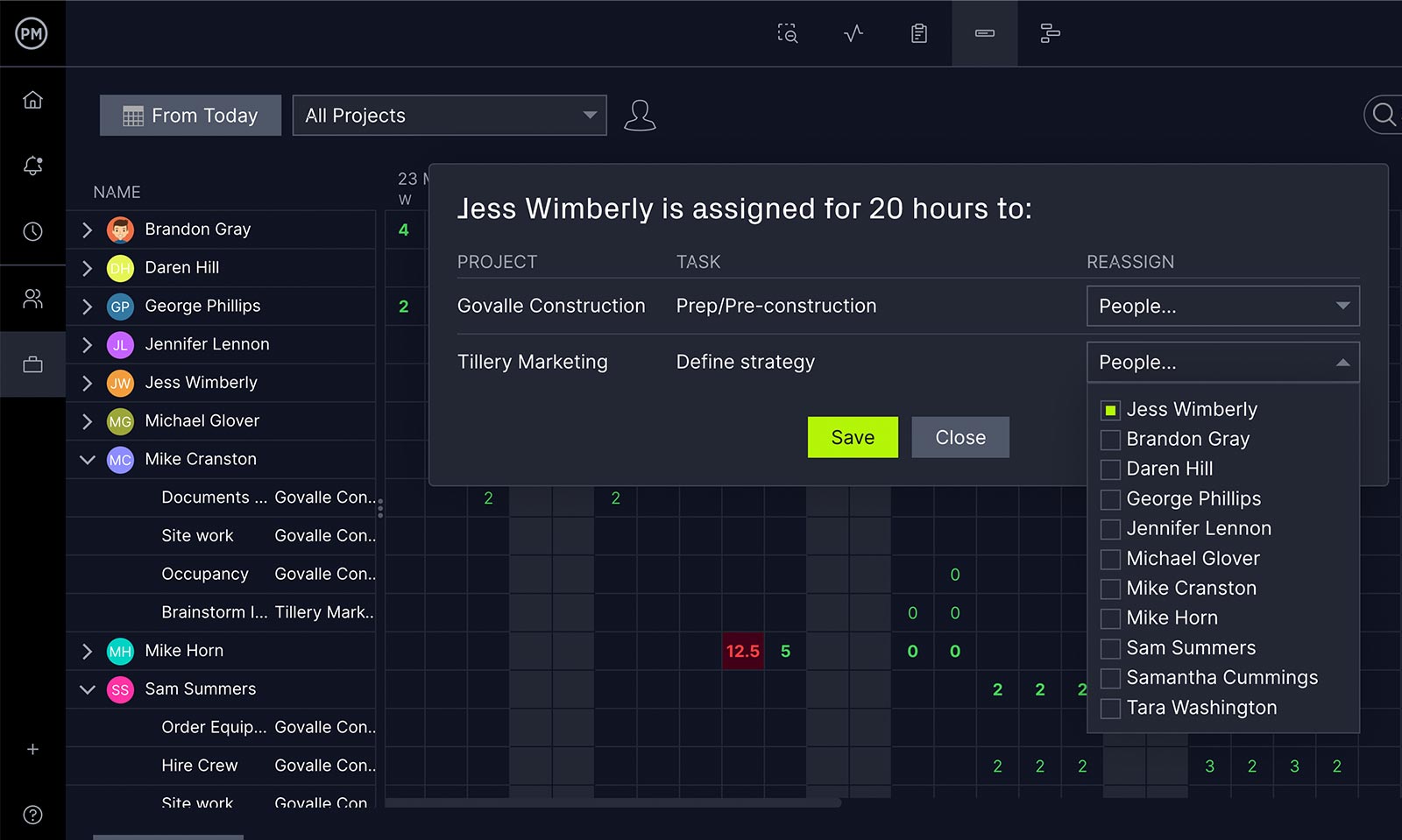
Monitor and Track Progress
Getting the most from your team means managing their tasks. You need a tool that has features to assign, monitor and track progress. A team management software that can do this in real time and automatically calculate key project metrics is essential.
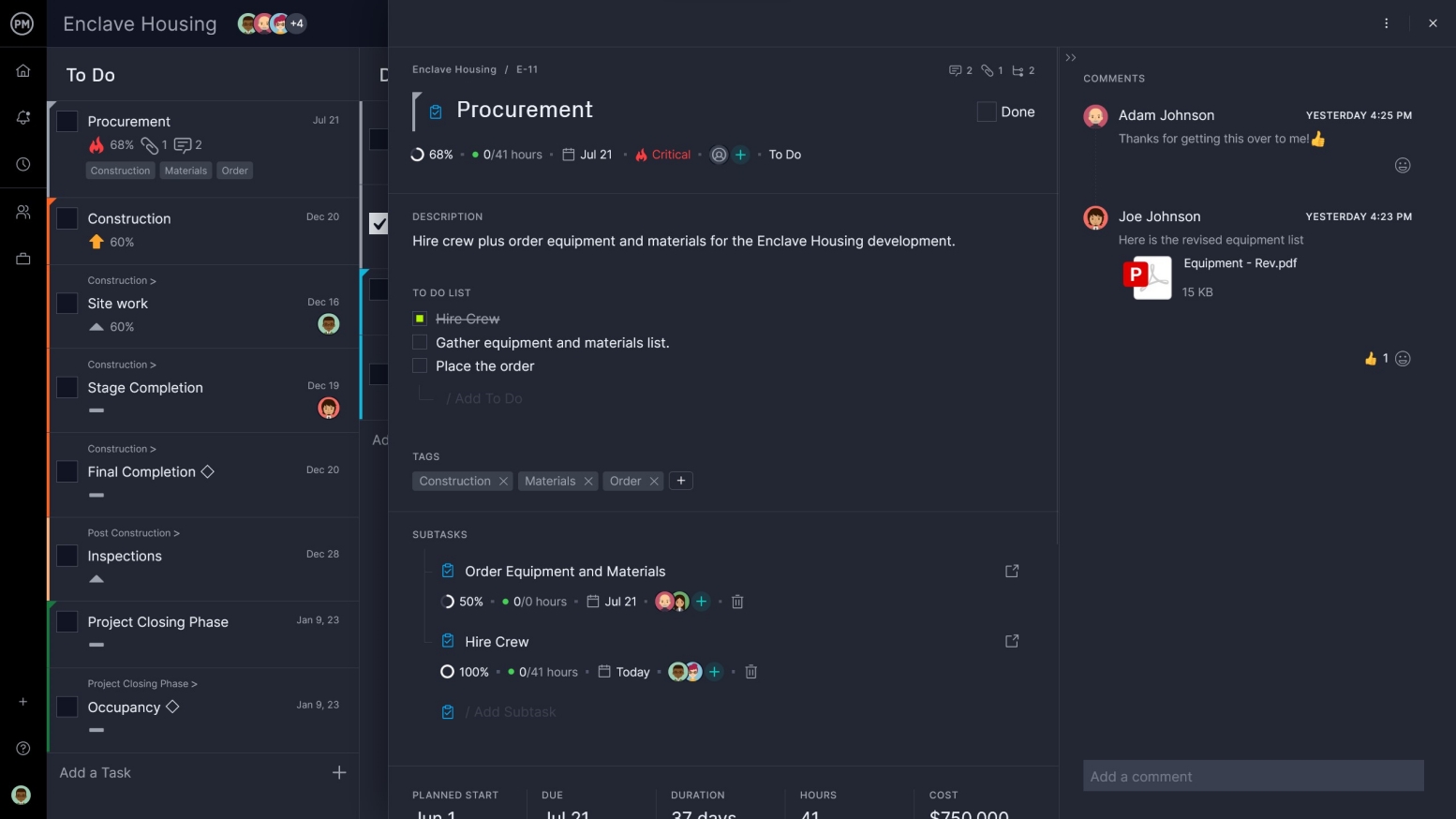
Flexible & Customizable Options
Keeping your data secure is important when working in a team management tool. Project security should be customizable, and the managers must have the authority to designate roles beyond the basic administrator, manager and team member.
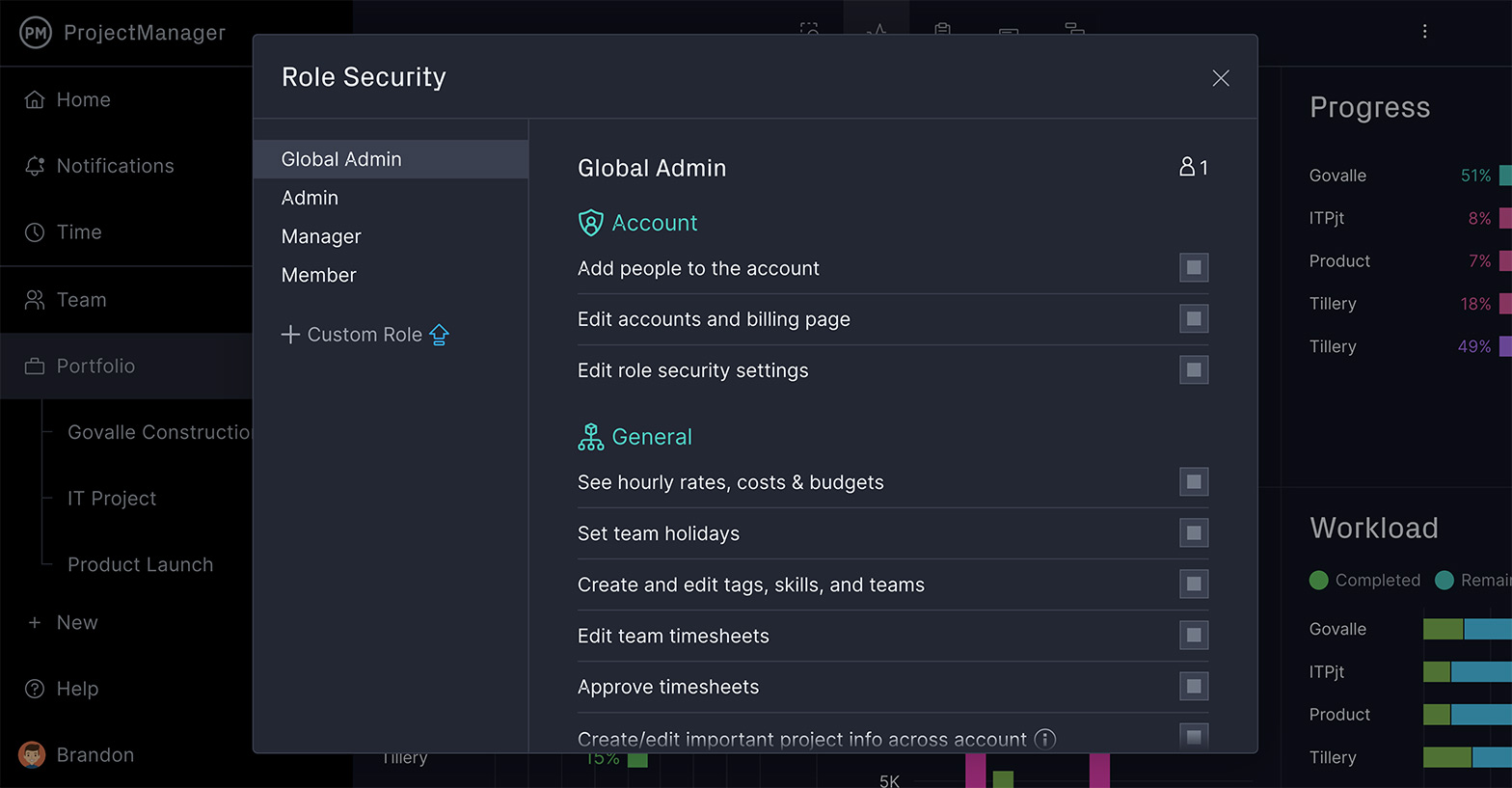
Monitor Your Team’s Logged Hours
Knowing how much time is left in the project, and how much time your team is spending on tasks, will help you stay on schedule. Dashboards give you a high-level view of the project, and timesheets and reports capture the hours logged by your team when executing their tasks.
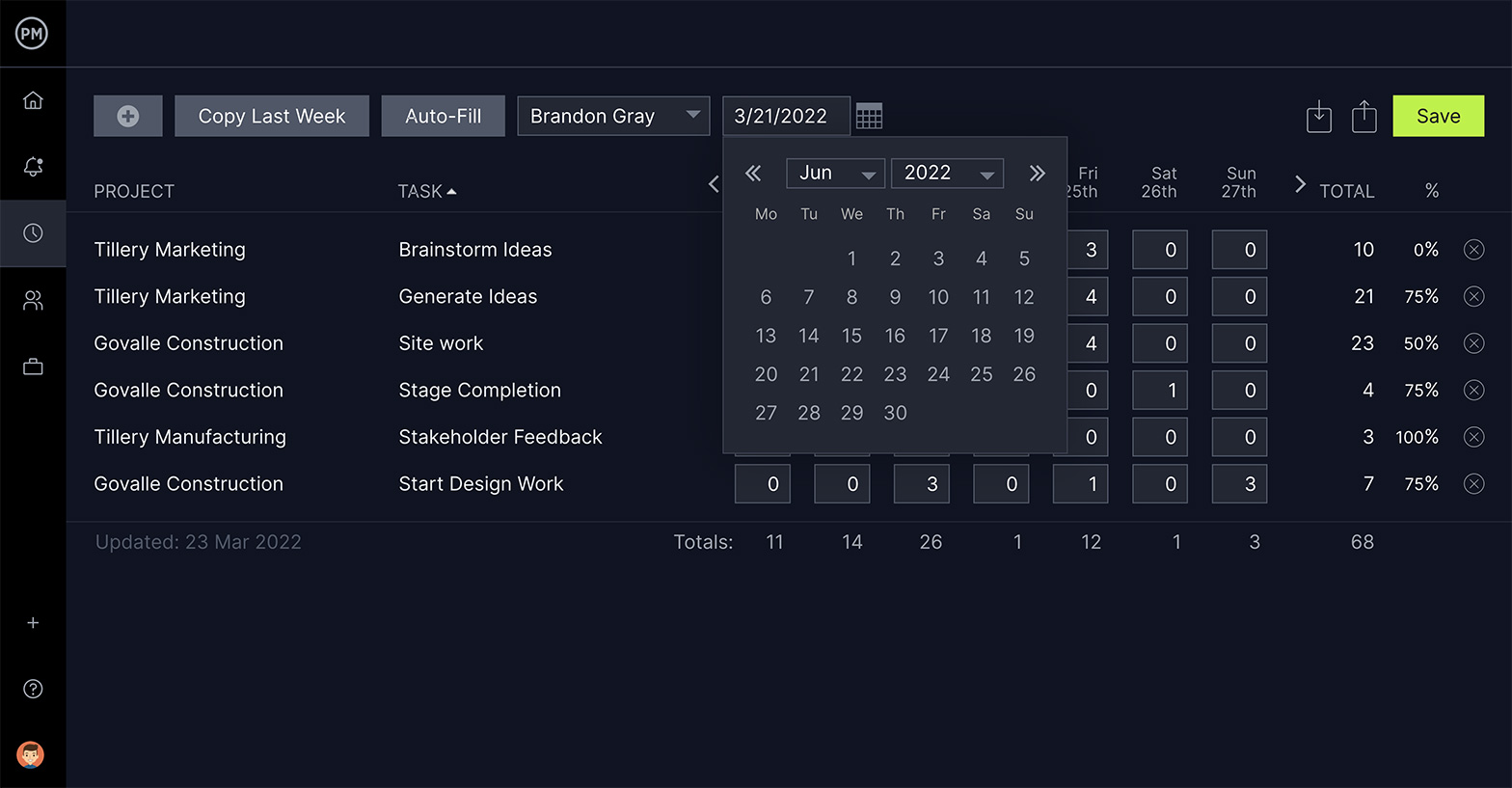
Know What You’re Spending on Labor
Having a handle of your costs keeps the project on budget. Manage your team to make sure they’re not spending more time and money executing the tasks than anticipated. You want a tool that can set labor costs, then use that baseline to track them later.
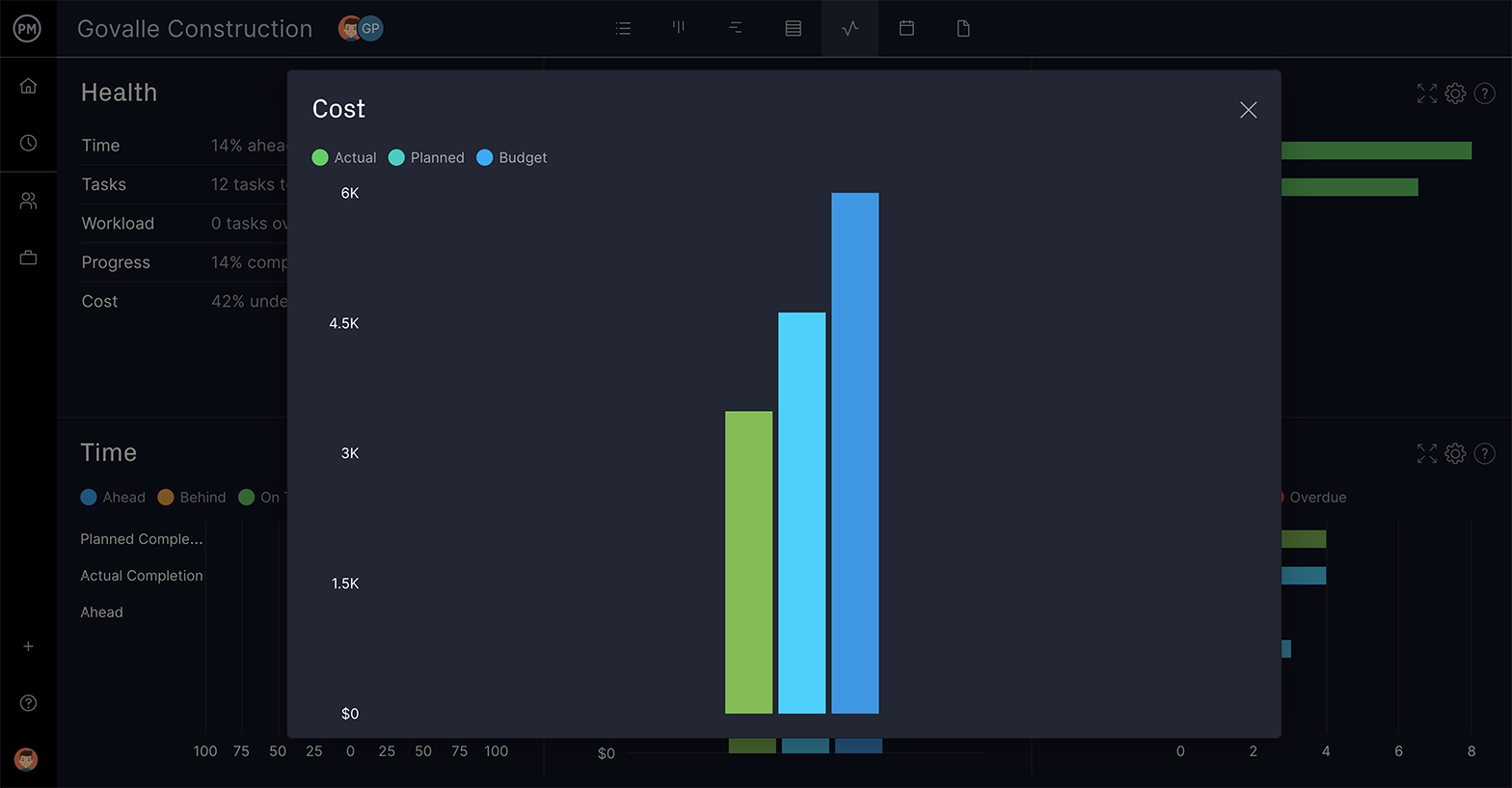
Get Teams Working Together
Connecting your teams and giving them the tools to facilitate working together leads to even greater productivity. Features that allow teams to comment at the task level and attach files to a task can provide clear direction for the project.

How to Manage a Project Team with Online Tools
Team management software helps project managers control their teams, communicate effectively with them and set their schedules and workload to meet their capacity with the resources they need to get their jobs done.
ProjectManager is an award-winning tool that better organizes teams and projects to boost productivity through increasing efficiency. This is how we help you manage your project team.
Onboard Your Team
Getting the team onboard is the first step. Getting started is a quick and easy process, and once in the interface, users will find an intuitive interface that avoids a steep learning curve.
Invite the team to the software with an email. All they need to do is follow the link, and they’re in. You can adjust their profiles, including their skills and labor costs, to use for future projects and to track costs.
Assign Tasks
Tasks are how your team interacts with the project. They were assembled to complete them. Prioritize, describe and assign them, so they have clear direction.
Describe tasks and attach any related documentation or images. Set the priority, so they know what to work on. Add resource costs and you can track them later.
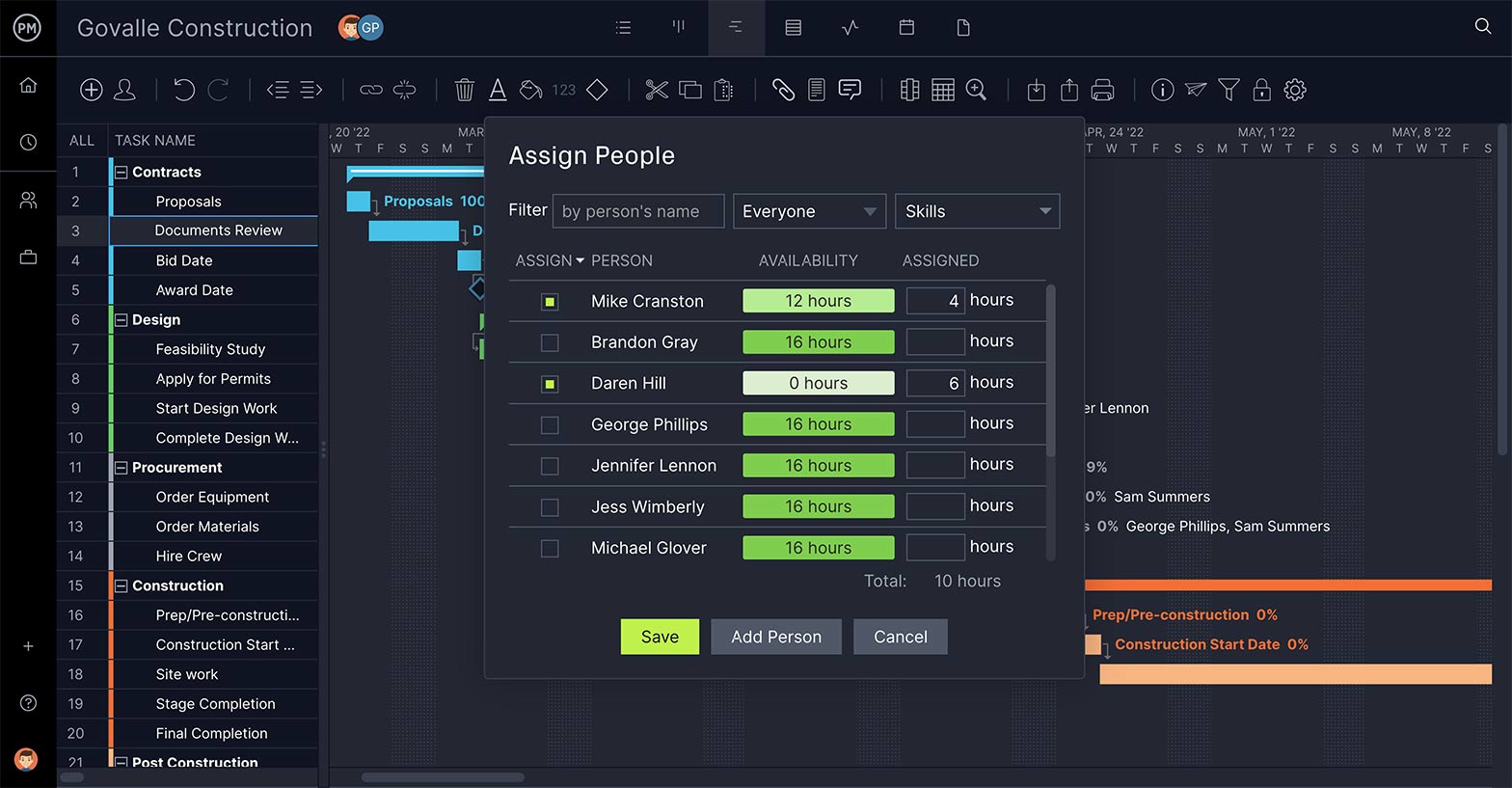
Use Multiple Views
Not everyone works the same, and therefore, they need different tools to meet their needs. Our team management software has the flexibility you need for effective cross-team collaboration.
Plan on a Gantt chart, with features to link task dependencies and set milestones. Then, visualize your workflows with kanban boards. See important dates on a calendar, and mark off tasks on the list view.
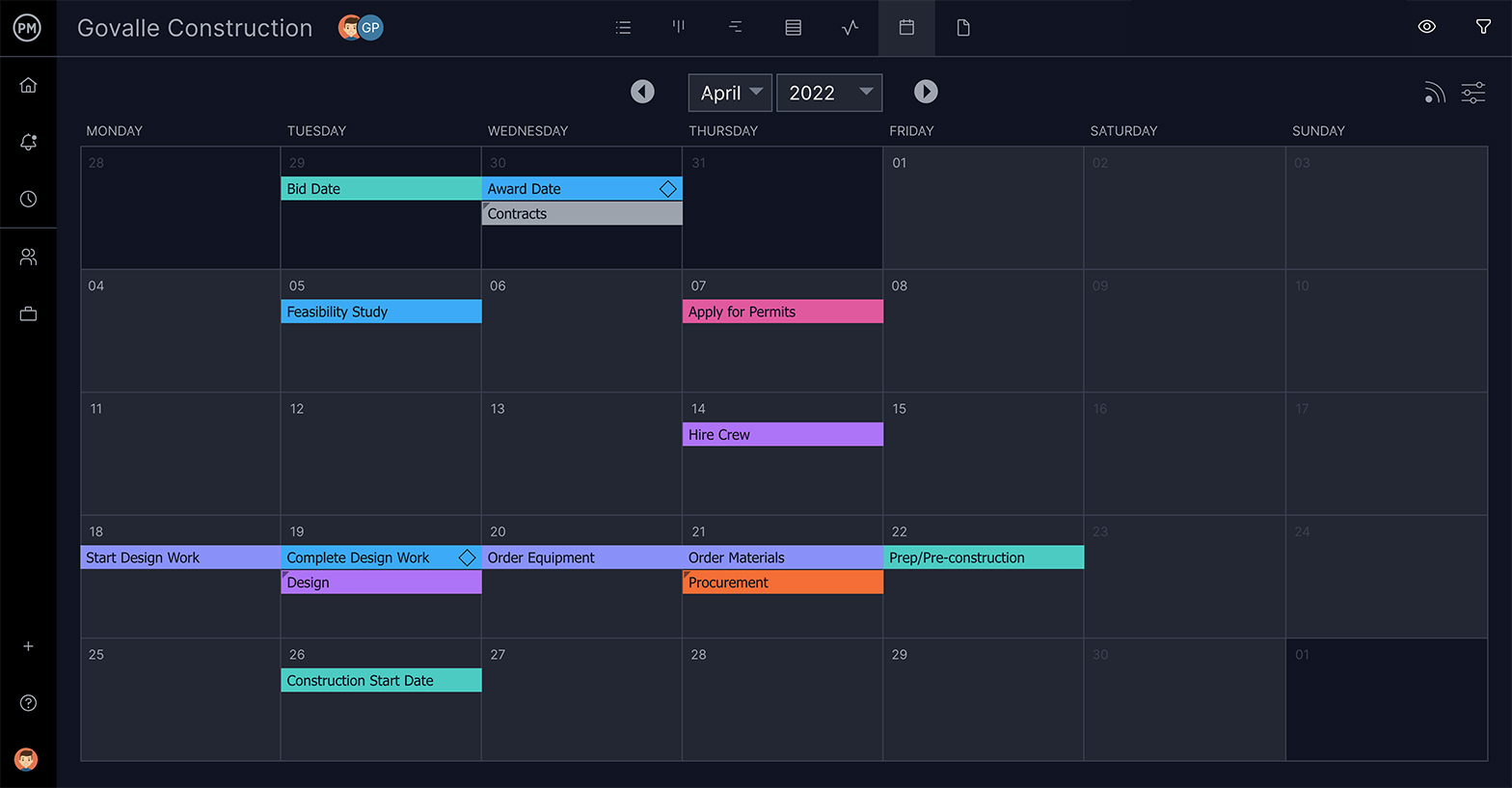
Get Transparency
Getting insights into your team’s work is the main reason to use team management software. You can get transparency, without getting in their way. It’s especially useful for managing distributed teams.
View the team management page to see your entire team, the tasks they’ve been assigned, their due dates and the task’s percentage complete. Know their progress anytime, anywhere.
Work Better Together
Team management software isn’t just about managing teams, it’s also giving them the tools they need to collaborate and work more efficiently to increase their productivity.
With ProjectManager, teams have a collaborative platform where they can communicate at the task level, get notified when the tasks they’re working on are commented on or updated, and can readily share pertinent files.
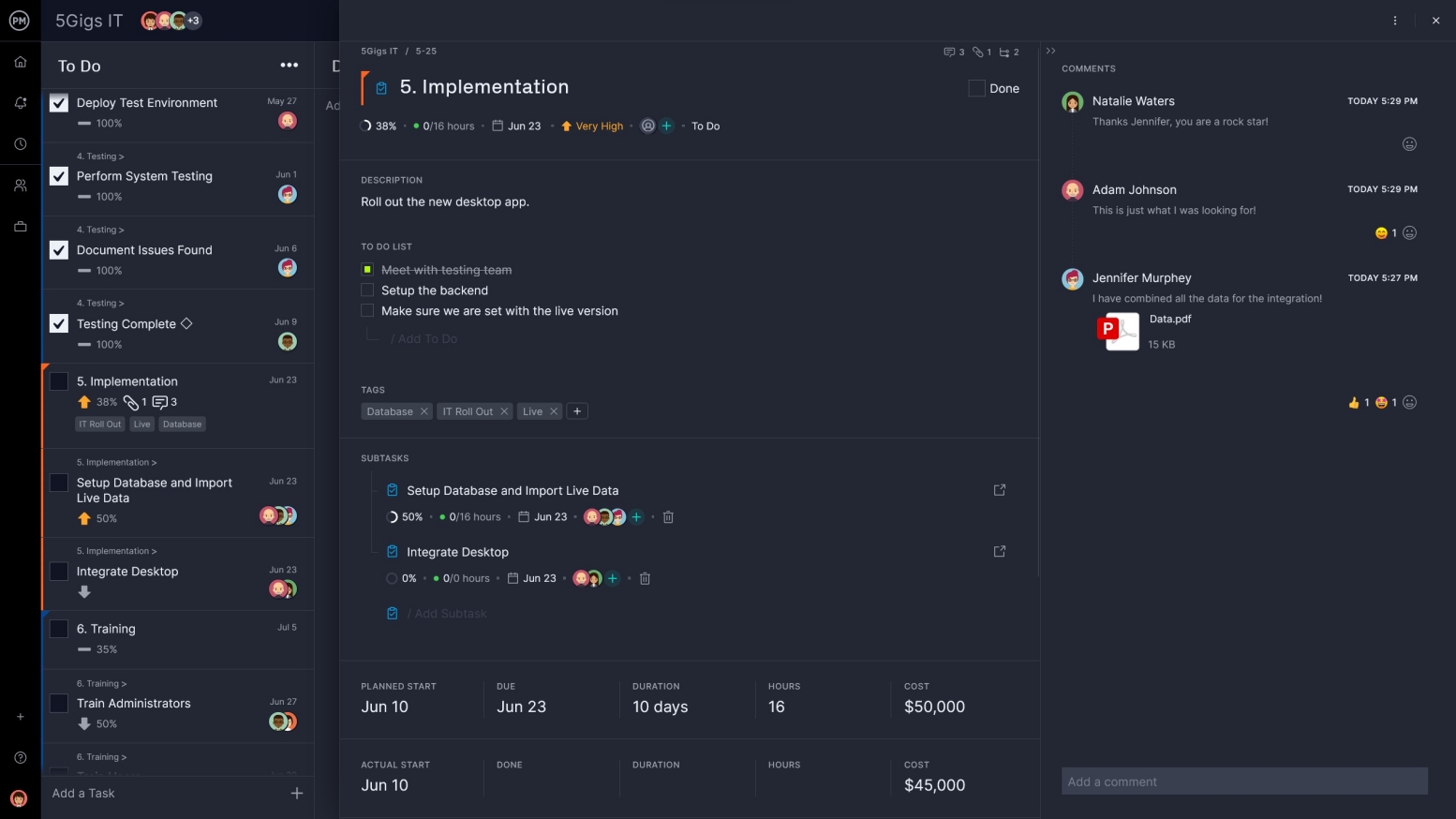
View Progress
More than just knowing the tasks your team is working on, team management software needs to give you a high-level view of the whole project, so you can make data-driven decisions.
See an overview of your project as it progresses across six metrics, measuring the overall health, costs, workload and more. All data is collected in real-time and automatically calculated for you.

Manage Resources
Resources are anything you need to complete the project, like teams, equipment, supplies and more. This includes your team’s tasks, and making sure everyone is well assigned.
View our color-coded workload page to instantly see who has too many tasks, and who is working on too few. Then, reallocate resources right from the page to balance workload.
Submit Timesheets
Timesheets are a tool to streamline the payroll process, but they are also another way to monitor the progress of your team as they log their hours over the week.
Use timesheets to keep track of your team as they log hours while working on their tasks. Timesheets are automatically updated when task statuses are filed, so you get real-time data.
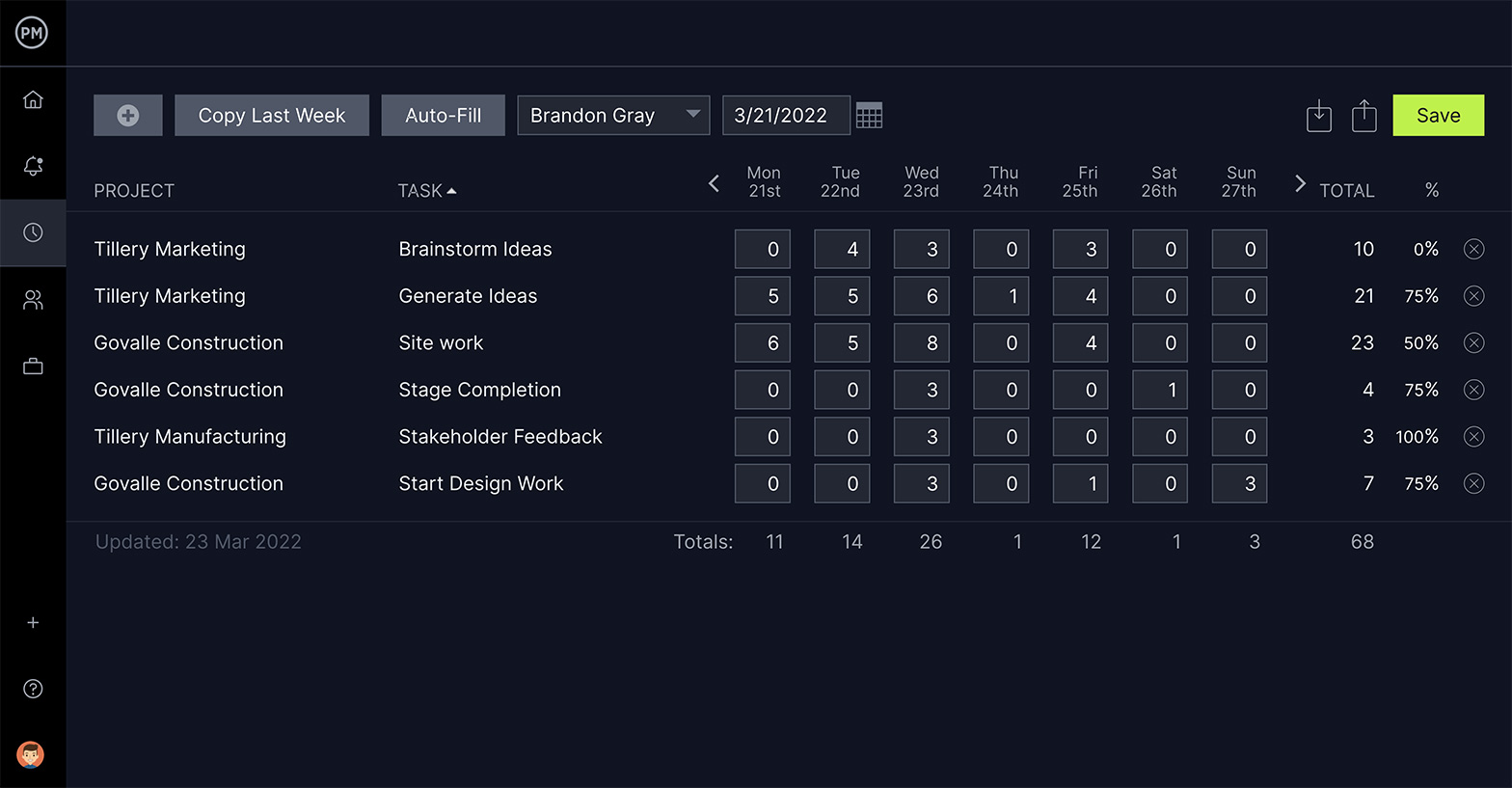
Go Deeper
Reports offer richer data, allowing you to get granular to measure aspects of the project not covered in the more general view of the dashboard. They also keep stakeholders in the loop.
Get reports with one click, and see details on project status, team availability, variance and more. Reports can be filtered and easily shared as a PDF for when you need to present to stakeholders.
How to Manage a Team
Team management is a tool to help team leaders inspire, guide and help their teams achieve the goals of the project. While every team is different, and there is no one right way to manage a team, there is a basic roadmap to follow that can make sure you’re hitting all the proper marks.
Transparency
Being transparent opens up the workplace. It helps teams feel more a part of the overall project, which helps them be more accountable, happy and creative—all important to productivity. This will help teams feel more secure, which in turn means they’re more likely to contribute ideas. The more open discussions, the more creative solutions. Keep your team in the loop. Respect them and value their contributions.
Acknowledge Work
Acknowledging good work is good for morale. That doesn’t mean you ignore problems. It’s part of the feedback loop. Positive feedback boosts your team’s confidence and helps buy in for their tasks. Bringing them into criticism, without being hurtful, can not only help resolve issues, but also show that you respect your team’s experience. Remember, they’re on the front lines of any project and whether it goes right or wrong. They will have the greatest insight as to why.
Delegate
Part of leading is delegating. You can’t do it all yourself, nor do you want to ride your team, micromanaging their every step. The team was hired because they have what’s needed to complete the project’s task; therefore, respect their skills and experience.
It’s not team management if you’re not giving your team work. To effectively delegate tasks, you’ll need to know who has the capacity, time and skills to do that work.
Manage Conflict
Conflict resolution is key to keeping your team working together. There can be personality issues, or people feeling that others are getting more responsibilities while they’re being overlooked. These issues come up in even the best teams, so you need to be on the lookout for them, and when a conflict arises, respond to it immediately. Conflict will erode the bonds that hold your team together, with disastrous results for both them and the project.
Be Decisive
Team management is about giving your team the tools they need to do their best work, but you are the team leader and must be decisive. Teams need leaders, even the self-directed kind. How involved you are depends on the team and the situation, but when it’s time to make a decision there’s no place for wishy-washiness. Just as your team is hired for their skills and experience, the team leader is also in place to do a job. They have the authority and need to use it, not abuse it.
Team Management Skills
Managing a team requires the proper mix of people skills and tools to keep schedules and workload balanced for optimum performance. The tools clear the path forward for teams, making sure that they’re never blocked or overallocated. The soft skills respond to the uniquely human relationships that make a team gel and perform.
Have a Vision
Team leaders need to have a vision for the project and project that to their team. That means uniting the team with a common goal and not getting bogged down in the day-to-day minutia. Without direction, teams can get confused or start filling the void at the top and moving off track. Therefore, vision— and communicating it well—are essential.
Be a Communicator
Communication is a key component to successful team management. Communication is based on being clearly understood, but it’s also about listening. You need to get feedback and respect other points of view that might be expressed. In terms of leading the team, you must make the priorities and long-term goals clear to the team, while acknowledging their successes and helping them resolve their failures.
Get Organized
Managing a team is complicated. Chances are you’re not only responsible for team management, but the whole project. That’s a lot of balls to juggle. To keep them all in the air, you must be well-organized. This means using the right tools to work more efficiently, being available for your team and letting them know when you can’t be disturbed.
Stay Firm But Fair
Confidence is bedrock. Teams respond well when they know someone is in control. But you’re not a dictator, and shouldn’t act as one. Never play favorites, always listen to any complaints and resolve conflicts. But the buck stops with you, and the team must know that you hold authority over any team management decisions. Do this right and you’ll earn their respect and team morale and retainment will be strong.
Remain Flexible
Remain flexible. It sounds like an oxymoron, but managing a team is a constant balancing act. You must always be willing to change. Projects are often thrown a curve, and if you’re rigid, you’ll never get back on track. Teams will develop conflicts, plans might have to change. Always be open to adapting.
Think Strategically
Teams want to work on tasks that are part of a larger strategy. They focus on the smaller stuff and they expect their team leader to have the big picture in mind, so when they’re in the trenches, the battle being waged is for a reason. The leader guides from this high-level view. It provides a sense of security that gives teams the confidence to focus on the work at hand.
Remember, You’re Part of the Team
The team comes first. You might have to act as an intermediary between the team and higher management if there have been issues with their work. You might need to stand up for a team member that is unjustly the target of other team members, or by management. Their wellbeing is more important than your label as their leader.
Team Conflict Resolution
We mentioned conflict resolution as a foundational pillar of any good team management, and it’s a subject that deserves more clarity. It will come up a lot. People can be difficult, but groups of people are always going to cause problems.
When conflict arises, the first thing to do is acknowledge it without bias. Talk to the person or people involved. As you discuss the conflict, focus on behavior and actions, not on the personalities of those involved. Most importantly, listen. This is their time to talk.
After you’ve heard the complaint (without comment or judgement), it’s time to identify the points where the people involved agree and where they disagree. Summarize these points, and make sure you have agreement on that summary from those involved. Then, prioritize them and see what’s most important to resolve.
Now it’s time to come up with a plan to resolve the conflict, beginning with the most pressing issue. The plan should not focus on past issues, but look towards future solutions and how to get there. You should set up future meetings with the people in conflict to make sure that things are progressing positively.
These things can take time, so stay with the plan and keep discussions open. Point out progress, compliment the people when they’ve made progress, and in time, the conflict will resolve itself. Of course, sometimes it doesn’t, but no more drastic step should be taken until you’re thoughtfully and honestly worked at resolving the conflict.
Team Recognition
To help avoid conflict, especially with the team leader, there’s something called team recognition. It’s a way to get the team to meet the goals and objectives of the project and keep them happy in the process.
Basically, team recognition is the bridge between management and the team leading to the success of the project. The team is supposed to fulfill their responsibilities and in turn be supported by management, who honors and respects their work. This is encouraged by reinforcement of behavior you’d like to see repeated.
Applying team recognition as part of your team management will help you retain employees and have less turnover, get better organizational results and help with goal setting, communication and accountability. But what about benefits for your team?
Team recognition is a two-way street. Teams will experience higher engagement, leading to more fulfillment on the job and generally feeling happier at work. Teams are more productive and have a higher morale. All of which leads to wins for management and workers.
Inspiring Teamwork Examples
There are many examples throughout history that illustrate the importance of teamwork. In this section we have selected some of our favorite inspirational examples of teamwork in a variety of circumstances. We hope that these examples inspire you and speak to the benefits of teamwork and collaboration!
1. Apollo 11 Moon Landing
One of the most historic examples of teamwork is the Apollo 11 1969 mission. While the world focused on the three astronauts, Neil Armstrong, Buzz Aldrin and Michael Collins, the former two who walked on the moon, most remember only Armstrong and his famous line upon being the first human being to set foot on the satellite: “This is one small step for man, one giant leap for mankind.”
However, behind that momentous moment are years of research and teams of people working diligently to do what no one had done before. Mission planners worked for two years prior to launch, studying the moon’s surface using satellite photographs in order to discern the best site for a lunar landing.
According to NASA, there were an estimated 400,000 people involved in making the moon landing possible. This included teams of scientists, engineers and technicians, many who had not worked in aerospace before. To make for a more cohesive team, the astronauts worked with many of these groups, making the human connection that is the blood of any team.
2. Wikipedia
The digital age is defined by teamwork, and one new media company illustrates that more than any other. Wikipedia is everyone’s go-to when they need a quick answer. It’s library of the internet, a collaborative engine of knowledge that is constantly evolving.
There were once encyclopedias that collected the world’s knowledge, but these are static volumes that are only updated every number of years. Also, what is printed between their covers is not up for debate. If you have a problem with what’s listed, you could write to the editors and maybe even get a response.
But Wikipedia changed that whole paradigm by recruiting an army of volunteer writers and editors who put the facts into its website. This simple but effective and massive example of teamwork is almost incomprehensible in its scope and yet runs surprisingly well. There are mistakes, but the site is built in such as fashion that these anomalies are quickly discovered. Teamwork is essential for Wikipedia because in a sense, everyone who has ever landed on the site is part of the team.
3. The Constitution of the United States
The Constitution of the United States is a foundational document of US democracy. It is also a prime example of teamwork. The then 13 states, all of which would have to ratify the constitution to make it the law of the land, were not united. There was no central government and the risk of the new nation falling apart was even more of a concern than it is today!
Debates raged over such things that we today take for granted like how long a president’s term should last. For four months delegates debated, until on September 17, 1787, the 39 delegates signed the historic document. Of course, that wasn’t the end of it. Now voters in each state had to approve. But the delegates did their job and the people ratified the Constitution in 1789.
Teamwork is not having one person force their way on the others: it’s about being open to compromise. All parties involved must find common ground and work together, because the end result is something all can benefit from. Just like the Constitution, which has been amended over the years as times and attitudes change, so teamwork must be a fluid process, not etched in stone, but always open and willing to improve.
4. The Beatles, Live in Hamburg
Everyone knows the Beatles. They defined the 1960s, moving from the Mersey Beat that made them a boy band that the girls loved to folk and psychedelic rock, inventing new genres seemingly with ease. Their music is the soundtrack of an era and continues to influence musicians to this day. But those are the flowers that grew from the dirt. That fertile soil that nourished and sustained them was far from their Liverpool home.
During the very early 1960s, before any radio play and Beatlemania wasn’t yet a word, they were the house band for a ruckus portside bar in Hamburg, Germany, called the Kaiserkeller. There they had to play for hours and hours, stretching three-minute pop songs into 20-minute jam sessions. It was in this crucible, that the four soon-to-be mop tops bonded musically. It was through live performances that they learned to put on a show, according to George Harrison on the Beatles Anthology DVD.
The magic of the Beatles is that four individuals learned through intense and extended live sessions to play as one, to anticipate each other and develop an almost intuitive communication. That set the stage which allowed their songwriting gifts to flourish. It was teamwork, plain and simple, that gave the Beatles the musical chops to develop their potential.
5. The Starbucks Expansion
It might be a joke now (how there’s a Starbucks on every block and soon occupying every storefront), but it wasn’t always like that. In fact, the dominance of Starbucks was never as sure a thing as it looks in retrospect or over its company timeline. Back in the early 1990s, Starbucks chairman and CEO Howard Schultz had opened a few hundred new stores across the United States, but the business was not successful.
The ambitious expansion was hitting problems concerning customer service and a lack of communication between various levels of the company. The company might have brewed a winning cup of joe but their customer service and employee engagement were staler than a pot of yesterdays coffee.
In 1995, Howard Behar became the president of Starbucks and with him came advancements in company culture. He cultivated a work environment that met the employees needs, which in turn inspired them to better serve their customers. It was through his belief that it was not the coffee they were selling but the customer experience, which gave Behar the mission statement to rally his teams to work together more effectively.
Get Team Management Software Free for 30 Days
ProjectManager is a cloud-based software that helps project managers and their teams work more effectively. Its team management features give you visibility into your team’s tasks, while the teams themselves get collaborative tools and multiple project views to work how they want.
Team management software integrates seamlessly with timesheets, team task management, planning, scheduling, monitoring and reporting features to give you more control over your project.
See why over 10,000 teams in organizations such as the US Postal Service, NASA and Bank of American use our tool to work more productively. Take our free 30-day trial today.
Team Management Resources
Software
- Team Management Software
- Best Team Management Software
- Resource Management Software
- Project Dashboard Software
- Timesheet Software
Templates
Articles
- How to Run Team Meetings: Tips & Best Practices
- Project Management Trends (2022)
- What Is a Virtual Team? Definition & Examples
- 6 Tips for Developing Cross-Functional Teams
- How to Manage with Servant Leadership
- 5 Team Productivity Blockers and How to Overcome Them
- How to Manage Your Team’s Workload
- 10 Essential KPI Metrics for Teams
- 25 Best Teamwork Quotes
Start your free 30-day trial
Deliver faster, collaborate better, innovate more effectively — without the high prices and months-long implementation and extensive training required by other products.
Start free trial